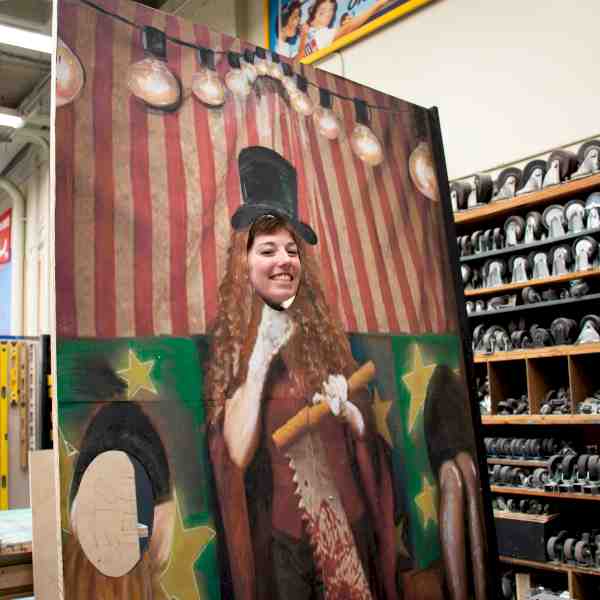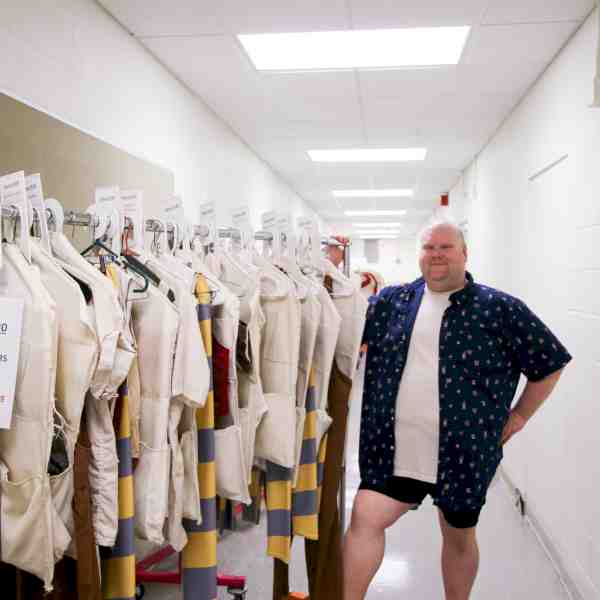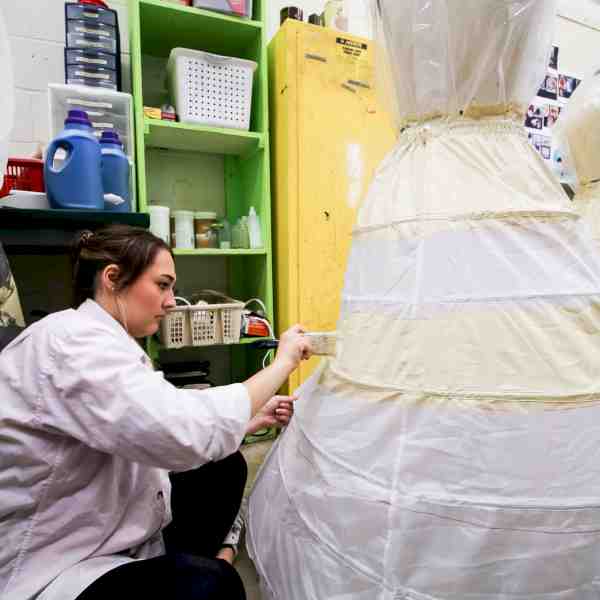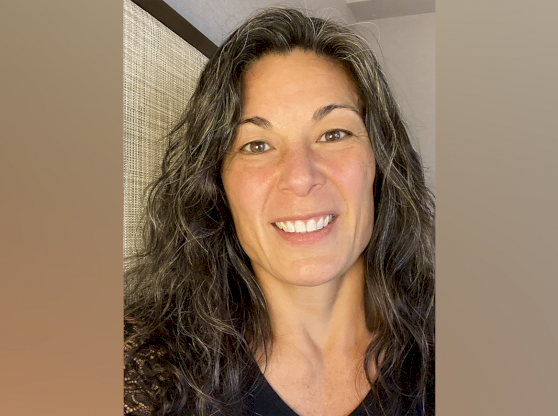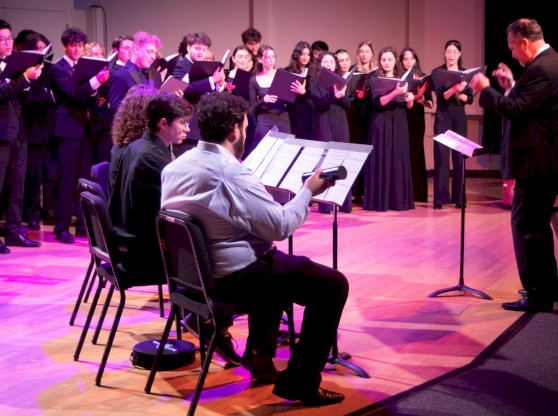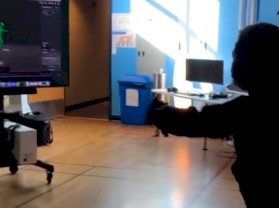“Lose yourself here and welcome to a world no longer your own!” rang through your ears as you cautiously walked through the doors of the Nadine McGuire Pavilion into a world rarely seen before at a University of Florida dance concert.
Standing in the lobby, prior to entering the Black Box Theatre through a very large and realistic lion’s head, dancers in eccentric costumes invited you to take photos and have your fortune told. Within seconds you become completely immersed within the world of the “sir·kus” and are ready to take on whatever awaits you on the inside.
Assistant Professor Elizabeth Johnson and Visiting Assistant Professor Dante Puleio, the ringmasters of this dark and whimsical concert, envisioned Dance 2020: sir·kus as an incredibly immersive experience that steered away from the typical proscenium style of staging and spilled into pre-show activities. From a mysterious fortune teller to a dazzling reimagining of vintage ticket booths, audiences were entranced from the moment they walked through the doors of the Nadine McGuire Pavilion and stepped through a great, grisly lion’s mouth, to the moment they left the building.
“Dance, especially contemporary, is not always approachable,” Johnson said. “This is a big enticement. A way to welcome people into a space that might be unknown and challenging.”
“And you can be comfortable,” Puleio added.
“Or uncomfortable,” Johnson said.
A strongly thematic concert with a concentrated effort towards continuity among the choreographers—including dance faculty Jason Aryeh, Isa Garcia-Rose, Augusto Soledade and Trent D. Williams, Jr., as well as Johnson and Puleio—was an unexplored but exciting endeavor for the annual faculty concert. Student designers were tasked with breathing life into this sinister circus in the areas that dance couldn’t on its own.
Peta McKenna, a third-year MFA candidate in scenic design, was intrigued by the challenge to create two individual but related design concepts—one for the Nadine McGuire Pavilion and one for inside the Black Box Theatre—in the time she typically had to create one.
“Immediately after the first design meeting, Puleio was like, ‘I want a circus and maybe we could have a cool entry,’ and I was like, ‘We're going to have a lion’s head!’” McKenna said.
With help from the School of Theatre & Dance’s set shop, McKenna also constructed multiple interactive cutouts where audiences could step right up and take photos in popular circus vignettes with a menacing twist, like a magician wielding a bloody saw in the sawed-woman-in-half illusion.
“With Instagram and Facebook, everyone wants to take pictures, so I thought, ‘Well that’s fun!’ [If you] put that out there, people will interact,” she said.
The ticket booth was another opportunity to blur the ordinarily strict line of when a concert begins.
“With the ticket booth, I wanted you to physically go up to something to get your ticket, like you felt like you were like a little kid going to a circus,” she said.
Inside the Black Box Theatre, the set design needed to complement each distinct dance piece while staying true to the overall foreboding feel. McKenna achieved this by centering the design on one main event: a large, weathered circus tent that appeared to have seen better, brighter days. With functioning drapes that opened at the start of each act, the tent anchored its top with a screen for video and photo projections offering transitions, warnings, or other visual information to audiences. Phrases like “fame” or “laissez les bon temps rouler” (Cajun French for "let the good times roll") provided undertones specific to each dance piece within a larger set piece that saw very little change. Inspired by McKenna’s research into creepy circuses often found in frightening forests, a dark starry background enveloped the tent and lit up like the night sky.
Aside from the added layers of difficulty that come with designing immersively thematic concepts, there was also a cultural barrier McKenna had to overcome. Originally from Australia, McKenna was unfamiliar with the American idea of a circus.
“When I was coming up with the concept, I was doing an internship in Sarasota at the Asolo Repertory Theatre and next door is the Ringling Circus Museum, and see, I had never heard anything about it,” she said.
McKenna mentioned to one of her fellow designers there about her upcoming circus-themed design project.
“He was like ‘Well you better go next door!’ So I went next door and I was like, ‘Oh my god, this is amazing!’”
Fellow graduate student and costume designer Matthew Limerick also pinned their research on circuses from time’s past.
“What I did was thematically look at each piece, the story each piece was telling, and I went historically with a lot of things,” they said.
Limerick looked towards P.T. Barnum and the American circus craze that blanketed the early half of the 20th century for references, while also combing through Instagram to help modernize these historical styles.
“We had a lot of inspiration that we had to pull in and unify because we are also putting ninety-six costumes on fifty-six people, so we needed a combined throughline that went together to help tell the story visually,” they said.
When it came time to sketch, Limerick sat down with co-designer Helen Peterson and listened to each dance piece’s music as the pair brainstormed ideas and drew initial sketches.
“It just kind of came to us,” Limerick said.
“With dance, a lot of times you’re visually telling a story and there is not a lot of speaking or there is not a lot of narrative that comes. There is a ton in the movement but nothing necessarily spoken,” Limerick explained. “Helen’s and my focus was making sure that we could tell the story for each number but still have some combined elements for all of them.”
The fluid motion that comes with the nature of a dance concert presented unique challenges when constructing the costumes. To ensure that dancers had a full range of motion, leggings were custom printed with more of a yoga cut and better stretch than typical pants. This customization also allowed for their fit to complement the different body types seen onstage.
“We are at a point where theater and dance are putting more body types and gender identities onstage, which is amazing, and we want to honor those people as much as we can,” Limerick said.
Limerick and Peterson’s designs provided dancers with options to match the fit and comfort level of each dancer.
“Everyone is wearing more or less the same thing, but there are little variations here and there so that we are fitting the body types, and we are fitting everybody's comfort levels as well,” Limerick said. “Especially in the college level, everybody’s comfort levels are different, and so we also picked things where we could add things on top.”
This kind of costume design and construction strengthens dancers’ individual agency so that they are more than just models of a design. Instead, they are active participants in what they are wearing by having the designs fit to them rather than being fit into the design.
This sense of agency harmonized with the immersive nature of this concert, as dancers were pushed offstage and out their comfort zone to interact and guide audiences through an active and eerie experience with dance. Grounding a dance concert in this dark fantasy of an underground circus asked dancers to be even more vulnerable than they may have been accustomed to, but it encouraged them to experiment and play with characterizations and interactions.
As Elizabeth Johnson said, “Circus is play.”

